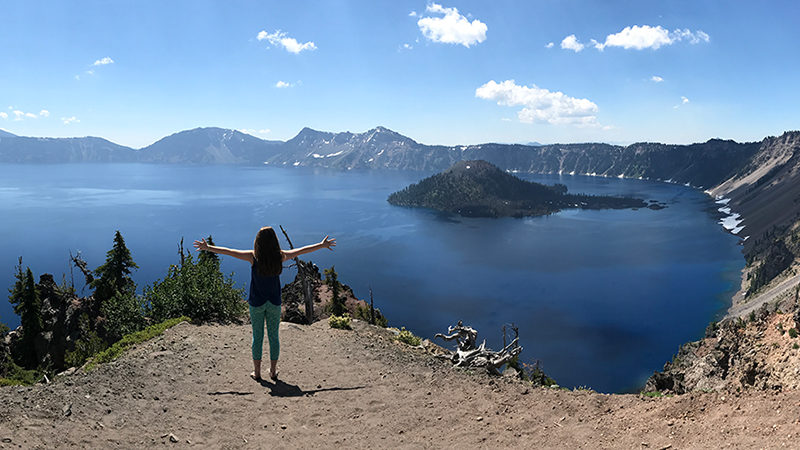
Driving the scenic road around Crater Lake means stopping at one jaw-dropping, stunning scenic viewpoint after another. You might think that repeated views of the same lake from different vantage points may get old… but it doesn’t. Every stop offers something different or unique to experience.
After checking out the fossilized steam vents in Annie Creek Canyon on our way into the park, and taking in the views at Discovery Point Overlook — the spot where Crater Lake was first discovered — and Watchman Overlook, we moved onto Merriam Point Overlook.
Merriam Point Overlook boasts panoramic views of Mount McLoughlin and Mount Scott, Llao Rock, and Wizard Island. Located at the junction of Volcanic Legacy Scenic Byway and Rim Drive, Merriam Point is often the first scenic viewpoint experienced by visitors who enter Crater Lake National Park through its North Entrance.
There are several small parking areas along the wide expanse of Merriam Point. We parked in the first one and hopped out to wander the overlook and enjoy the view. Crater Lake’s easy to moderate Rim Trail parallels Rim Drive, connecting Rim Village, Discovery Point, and Merriam Point, so we walked along the last bit of the trail, past old, wind-blown, gnarly trees and stretches of snow to an amazing viewpoint looking out over the lake at the dacite cliffs of nearby Llao Rock.
At the Llao Rock Overlook, you’re much closer to Llao Rock, so this is a great place to really experience just how big the massive formation is!












The Naming of Merriam Point
Merriam Point and Merriam Cone, which is hidden beneath the surface of Crater Lake, are named for paleontologist and conservationist John Campbell Merriam. Merriam contributed to the establishment of John Day Fossil Beds State Park and in the 1920s, became director of the Carnegie Institute in Washington. In that role, Merriam was able to augment federal funding for the Sinnott Memorial Observation Station.
Know Before You Go
- Crater Lake National Park, Oregon’s only national park, does not have a physical street address, so it can be hard to locate us using GPS. We made the historic Crater Lake Lodge our first stop, which is located at 565 Rim Drive, Klamath Falls, Oregon 97604.
- At 1,943 feet deep, Crater Lake is the deepest lake in the United States and the principal feature of Crater Lake National Park.
- The 33 mile Rim Drive that travels around Crater Lake’s caldera features spectacular views of the lake and interpretive signage at all of the main vista points.
- Good for seven days, admissions fees are $30.00/vehicle, $25.00/motorcycle in the summer and $15.00/motorcycle in the winter, and $15.00/pedestrian or bicycle.
- The national park is open year-round, 24 hours a day but many of the park’s roads, trails, and facilities are closed seasonally.
- During periods of rain and snow, Crater Lake is often hidden by clouds — it is completely invisible about 50% of the time in the winter!
- Summers at Crater Lake are short but typically sunny. July, August, and September are your best bets for warm, dry weather. However, it can snow any day of the year.
- The park’s North Entrance is closed for about seven months each year. It closes at the first snowfall or on November 1, whichever comes first and reopens in early to mid-summer. The park’s South Entrance and West Entrance are open year-round. We visited the park in late July and the roads had only been open for a week!
- Crater Lake National Park has two visitor centers. The Steel Visitor Center at Park Headquarters is open every day except December 25 — 9:00 am to 5:00 pm from mid-April to early November and 10:00 am to 4:00 pm the rest of the year. The Rim Visitor Center at Rim Village is open daily from late May to late September from 9:30 am to 5:00 pm.
- Dogs on-leash are permitted within the park but only within developed areas and within Mazama Village and Lost Creek Campground. Dogs are not permitted on any trails or in undeveloped areas.